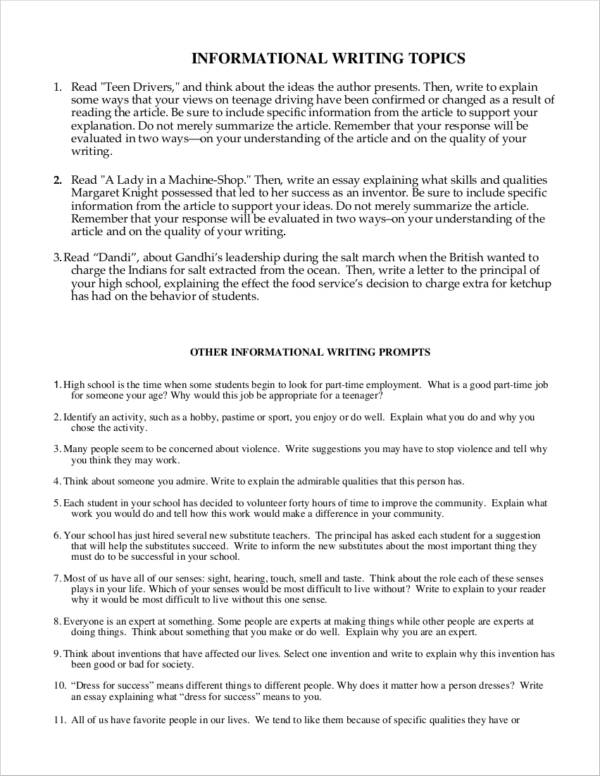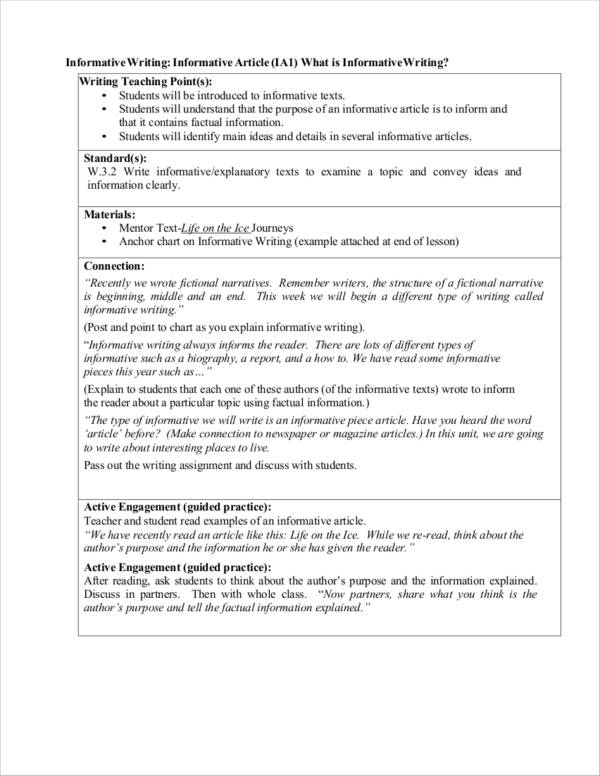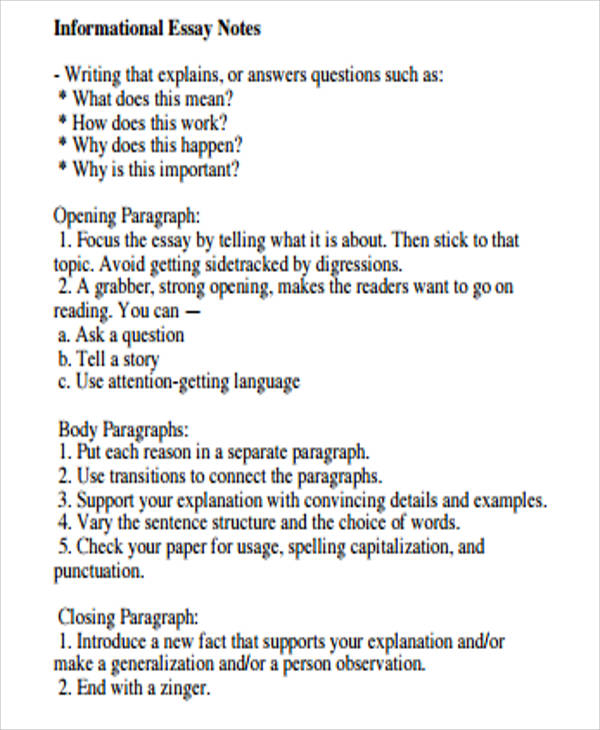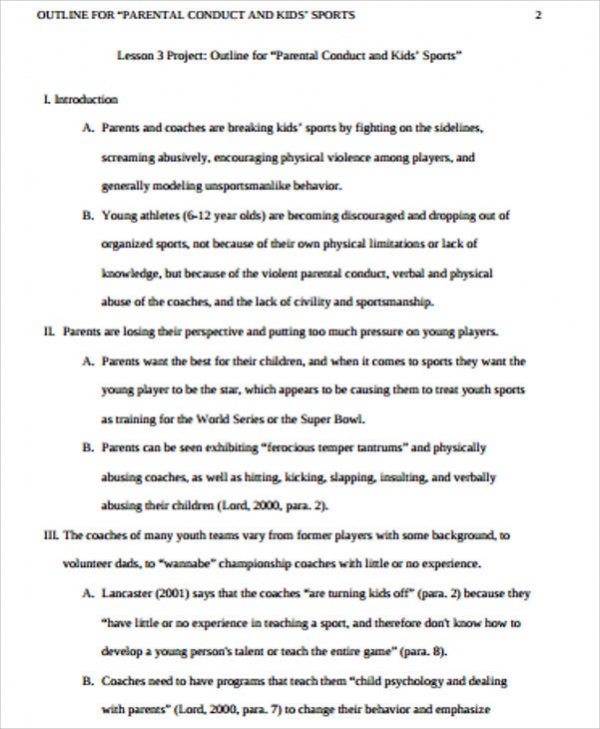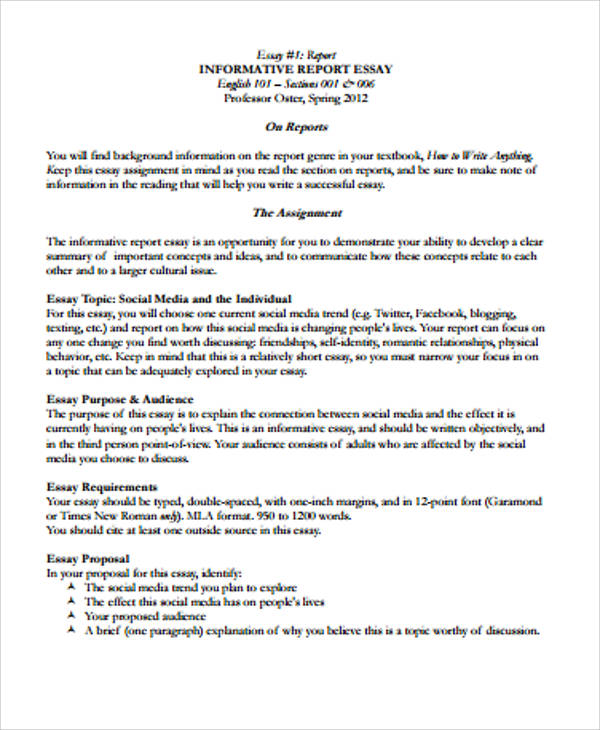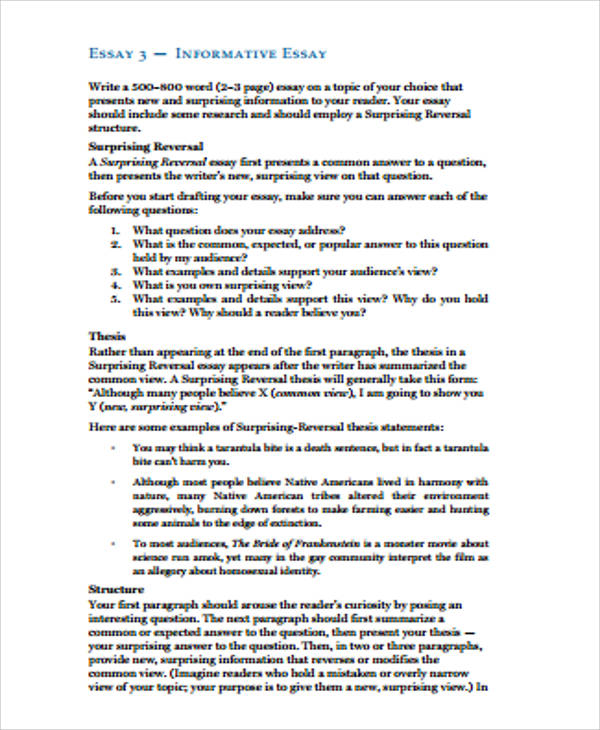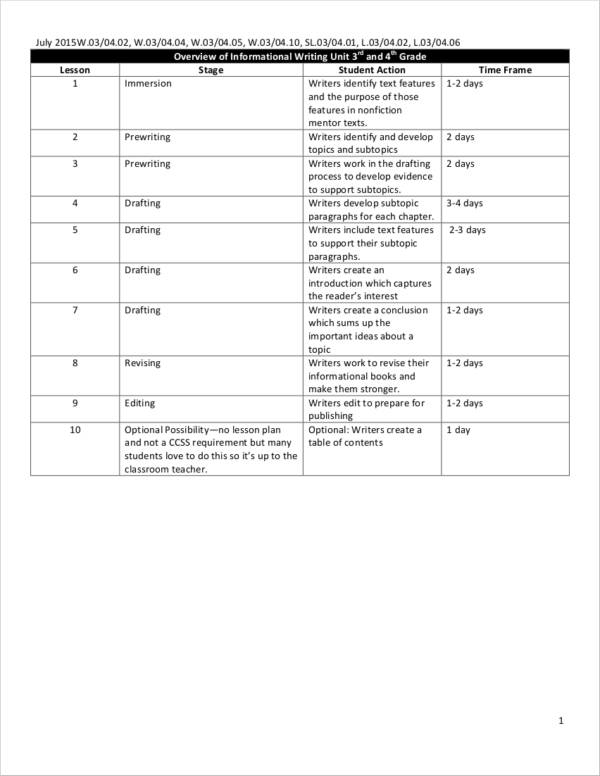Informational writing, also known as explanatory writing, is a type of writing style that mainly focuses on letting readers know about facts. This type of writing is fairly common in newspaper, encyclopedias, and books. This is also very organized in order to make sure that all the information that the reader needs to know has been relayed properly. You may also see business writing samples and templates.
- Free Writing Samples
- Useful Writing Templates
If you need tips and more information regarding informational writing, you should make sure to keep on reading. We also have a couple of informative writing samples and templates that will help you come up with a well-written essay.
Informational Writing Prompt Samples
Informational Writing Sample Guide
Informational Essay Notes in PDF
What Are the Features of Informational Writing?
Structure-wise, an informational essay
- has a clear introduction,
- has vague discussion about the topic (introduction),
- has specific details about the topic (body of the essay),
- has a synthesized conclusion,
- piques the interest of the audience, and
- easy to read and comprehend.
When it comes to the language used, it
- makes use of the present tense,
- can either be in the first person perspective or third person perspective, and
- is coherent.
Coming Up with an Informational Essay Outline
An essay outline is one of the best ways of ensuring that your informational essay ends up becoming organized and clear in the information that you are trying to relay. This is really helpful for experienced writers and newbie writers alike. Since informational essay is factual and objective in nature, the outline will help to ensure that you will be able to stick to the idea you have in an easier manner.
Coming up with an outline before writing the draft of your essay will help you narrow down what you want to focus on in your informative essay. Since informative essays are quite common in academic settings, it would be a good idea to plan your essay to be a brief one but still being able to relay all the pertinent information that your reader must know about the topic at hand.
Here’s what a basic informational essay outline looks like:
1. Introductory Paragraph
Your introductory paragraph will include the following:
- A topic statement will help to organize your introduction and this is the sentence that will also introduce what your thesis statement is for the essay. This also establishes what the whole essay is all about.
- A thesis statement is a statement that will help to establish to the reader what will be argued all throughout the essay.
2. The Body of the Essay
The body of the essay is typically composed of three paragraphs. Each paragraph is composed of three main parts:
- Transitional phrases (“First of all,” “Secondly,” “Then,” “Also,” “Moreover,” etc.)
- Restatement of thesis
- Main point
3. Conclusion
The conclusion of the essay will put together everything that you have been discussing from the introduction to the body of the essay. It will have the following components:
- A transitional phrase (“In conclusion,” “Therefore,” “Lastly,” etc.)
- The summary of the essay
You may also see book writing samples.
Informative Essay Outline
Informative Report Essay
Informational Report Essay
Informational Essay Example
Grade School Informational Writing Unit
Writing an Informational Essay
Step 1
- Review guidelines that you have.
- Narrow down your preferred list of topics for your informational essay.
- Take note that the main focus of your essay is to educate instead of imposing your own opinions. So remember to choose a topic that is easy to research about or you think you can write about. You may also like article writing samples and templates.
Step 2
- Organize your thoughts and ideas in an essay outline. You can follow the tips that we have mentioned above.
- If you have questions regarding your topic, write these down and list the actions that you will do in order to remedy that question. You may also check out minutes writing samples and templates.
Step 3
- Do your research. When you are researching, make sure that you take information from credible websites and journal entries.
- Analyze what you have researched and synthesize. You may also see reflective writing samples and templates.
Step 4
Write Your Introduction
- Start with the topic and make it catchy to grab the attention of your readers.
- Include background information.
- Make your ideas vague and be more specific in the body. You may also like memo writing samples and templates.
Step 5
Coming Up with the Body of the Essay
- Write down all of the relevant information that you have researched. This will include a wide range of sources and facts.
- Make sure that what you are including is accurate information. You may also check out job application writing samples and templates.
Step 6
Write the Conclusion
- Reiterate the issues and the main points of your essay.
- Avoid introducing new information.
Step 7
Synthesize Everything
Make sure that all the information that you want to share is reflected in the essay and that the overall tone of your essay is objective. You may also see summary writing samples and templates.
Post-Essay Writing Task
1. Check the Vocabulary
Make sure that you edit out words that do not make sense or make the main thought have a different meaning to it. You may also like speech writing samples and templates.
2. Review the Grammar
Grammatical errors can aggravate your readers and it also gives the impression of being unprofessional and being careless.
3. Cohesiveness
It is important that everything in your essay is cohesive in nature to ensure that everything flows smoothly. Make use of simple language to make it easy for your readers to understand what you want to relay. You may also check out narrative writing samples and templates.
4. Ask Someone to Take a Look at Your Essay
A fresh set of eyes would be a great way of ensuring that your essay ends up being well written. Ask a friend or your teacher to check your essay and ask for recommendations and suggestions for improvement before you submit it. You may also see technical writing samples and templates.
5. Adding the Final Touches
Once you have done all the changes in your draft, it’s time for you to start writing your final draft. Once you are done with your final draft, give it one more read through and fix what needs to be fixed. You may also like script writing samples.
Now you are done! It’s time for you to submit your essay. You may want to check out other essay writing samples and templates for more information.
Related Posts
Sample Business Card Templates
Sample Cashier Job Descriptions
Questionnaire Samples
FREE 10+ Sample HR Resource Templates in PDF
FREE 10+ HR Consulting Business Plan Samples in MS Word | Google Docs | Pages | PDF
FREE 49+ Sample Job Descriptions in PDF | MS Word
FREE 16+ Nonprofit Budget Samples in PDF | MS Word | Excel | Google Docs | Google Sheets | Numbers | Pages
FREE 13+ Academic Calendar Templates in Google Docs | MS Word | Pages | PDF
FREE 10+ How to Create an Executive Summary Samples in Google Docs | MS Word | Pages | PDF
FREE 23+ Sample Event Calendar Templates in PDF | MS Word | Google Docs | Apple Pages
Company Profile Samples
FREE 10+ Leadership Report Samples [ Development, Training, Camp ]
FREE 24+ Sample Payment Schedules in PDF | MS Word
FREE 10+ Return to Work Action Plan Samples in PDF | DOC
Autobiography Samples & Templates

